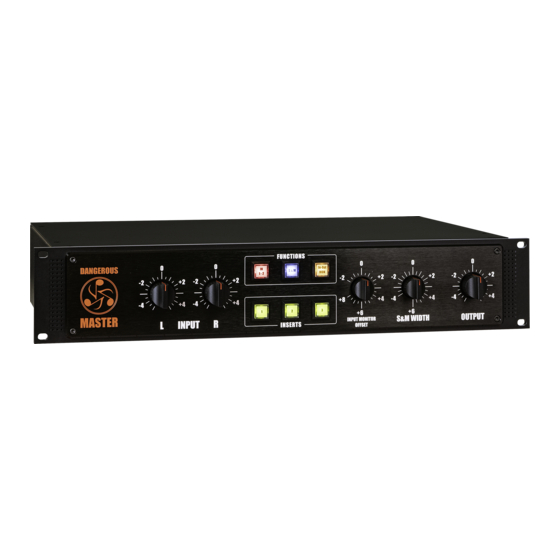Dangerous Music Master Handbuch für Einrichtung und Betrieb - Seite 3
Blättern Sie online oder laden Sie pdf Handbuch für Einrichtung und Betrieb für Aufnahmegeräte Dangerous Music Master herunter. Dangerous Music Master 8 Seiten.
Auch für Dangerous Music Master: Benutzerhandbuch (16 seiten)

Overview
The Dangerous Master is easy to set up and use. It is designed to be the platform that
turns a few pieces of analog outboard processing gear, a D/A or analog source, and an
A/D hooked up to an editing computer, into the backbone of a mastering rig.
An analog source is fed to the input where the input gain control let's one precisely set
the level and balance into the insert stack.
Your favorite analog processing gear is hooked up to the inserts. When an insert button is
pressed, that loop is in line. The second loop can work in stereo or "Sum and Minus"
mode. In S&M, one can alter the center pan information of a mix without affecting the
sides and vice versa. For instance, the lead vocal is too bright but the guitars panned to
the sides are dull? Use stereo EQ in S&M to fix both problems! This kind of processing
makes a mastering engineer so equipped "King of the Mountain". The Width control
allows adjustment of the stereo image width. It works even when Insert 2 is not pressed
when S&M is selected. Remember, while S&M is fun, too much can be a bad thing!
The writer's favorite suggested processing goes like this:
Insert 1 gets a stereo EQ to set the tone correct for the rest of the stack.
Insert 2 gets a parametric EQ, De-Esser, and Limiter to fix any problem with a mix.
Insert 3 gets a Compressor to control dynamic range for loudness.
The Output Gain control let's one precisely 'hit' the A/D converter at the correct level.
The Input/Output Monitor Selector let's one compare the dry and processed signal and
there is an Input Monitor Offset control so that comparison can be made even after
adding several dB of loudness to the mastered signal. This also allows an easy way to tell
how much apparent loudness has been added to the signal (by matching the apparent
levels and reading the difference on the IMO gain control).
3
